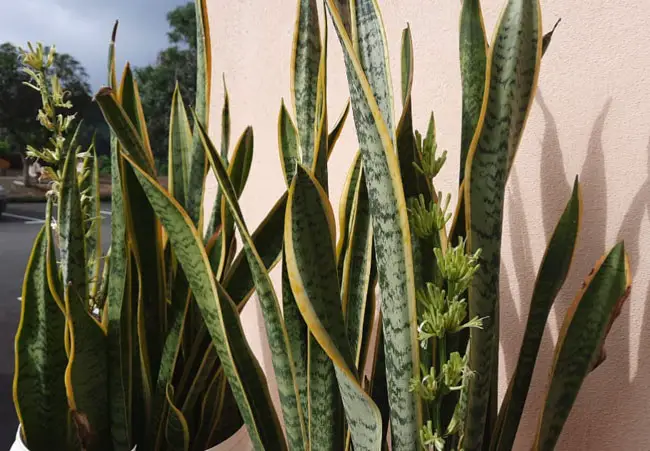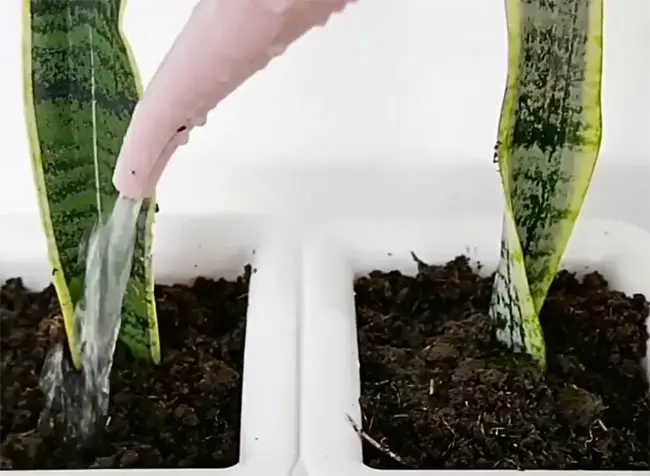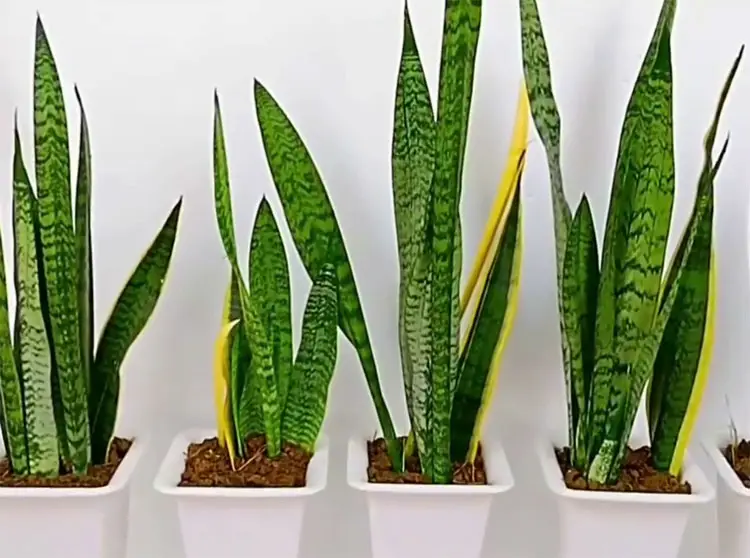Planting anything new or odd in your garden be a challenge, especially when you fall in love with the longleaf snake plant. A plant that looks like leaves growing straight out of the ground can make an amazing addition to the species you are growing in your garden. Many people that add these to their gardens wonder if you can water them with the same frequency as their other plants.
Depending on the season you are currently in, it would help if you watered your snake plants every 2 to 8 weeks, with summer months requiring more frequent waterings than winter. Snake plants will hibernate during colder seasons to save energy, growing a lot slower and changing color to match the season.
Knowing how often you should be watering your snake plants is just the start, with many of the plants heavily dependent on the weather you are living in. Colder countries will experience different growths of snake plants than tropical and hot countries. Learning how to judge when plants need water or when they have received too much water is an important skill that you should learn to apply.
How Often To Water Snake Plant In Each Season
It would be best to water your snake plants every 2 to 8 weeks, which is a confusing time frame to apply when it’s also raining or snowing. Many people think that they should wait until the seasons change to water their snake plants, usually forgetting that their plants may be indoors or that they may be going through a local drought.
You need to remember two main reasons when giving water to your snake plants, each one heavily affecting the type of growth that your snake plants will be experiencing. Sometimes you may need to water regularly to ensure that the snake plant is growing healthier and faster than it would naturally.
To ensure healthy growth during this season, it is important to provide adequate drainage when adding water. If using soil, mix in some perlite or gravel with organic material such as peat moss or compost. Clay pots help retain moisture while plastic containers allow excess water to escape quickly; either option is suitable depending on your preference.
When watering the snake plant in springtime, make sure that the top layer of soil feels dry before providing more moisture. Applying too much water can cause leaves to become yellowed and wilted, a sign that there may be problems with over-watering. With regular maintenance, you can keep your snake plant well-hydrated throughout the season for optimum health and beauty.
Summer
Many people assume that spring is the main season in which plants grow, and it is not wrong. However, once spring has come and gone, many plants will grow even faster.
The fresh sun and seasonal rain showers during summer in most countries are a growth booster that will see your snake plants rapidly growing. Some snake plants won’t enjoy these seasonal showers, as they are kept inside but will still feel the blistering sun on them.
When your snake plant is indoors, or your area is going through a slight drought, you should water it every 2 weeks, allowing it to receive the proper amount of nutrients. If you see the leaves of the snake plant changing color away from their natural look, you should be spacing out the watering by another week or two.
It’s also important to monitor the moisture content of the soil when determining how often to water. Stick a finger into the soil up to the second knuckle and if it feels dry then it’s time to water again; if not wait another week or so before checking again. Here are 4 tips on how best to water your snake plant in summer:
- Use lukewarm or room temperature water rather than cold tap water which could shock the system of your snake plant.
- Don’t let standing water accumulate in pots as this can lead to root rot.
- Avoid saturating leaves with excess water as this will cause them to yellow and wilt.
- Provide enough nutrients via fertilizer such that plants don’t require excessive amounts of supplemental irrigation.
Another important factor for successful Snake Plant care during hot weather is airflow around its foliage and roots. Place your pot in an area with plenty of air circulation like near a window or vent where there is a gentle breeze going through regularly, allowing extra oxygenation and helping keep humidity levels low. This will help prevent any issues caused by stagnant air and over-watering while providing optimal conditions for growth throughout the summer months.
Autumn
In autumn, snake plants require less frequent watering than in the summer months. This is due to lower temperatures and reduced sunlight intensity which causes a decrease in the transpiration rate and overall water requirements of the plant.
Generally, you should only water your snake plant when the soil has dried out completely or if it looks like it’s starting to wilt. When watering, always use room-temperature filtered water so as not to shock the roots with cold liquid.
Additionally, make sure that any excess moisture is drained away from the pot after each watering session. It’s also important to note that during this time of year, mature snake plants will rarely need more than one deep watering per month while younger specimens may still need weekly attention.
Lastly, humidity levels are also very important for healthy growth; try maintaining high relative humidity by misting your plants twice a week with distilled water. By following these simple steps, you can ensure that your snake plant thrives even in dreary autumn weather.
Winter
Winter in most countries where the snake plant is growing will be a place that experiences now shallow temperatures. Usually staying moderately temperate even on the coldest of nights, these countries are tropical and have defined how the plant grows in winter. Usually with a slowdown in growth, but not a complete stop, as these countries will experience less rain during their winter seasons.
It would be best to water your snake plants every 5 weeks or more as the plant will slow down its growth during the winter season. This is a natural part of the snake plant cycle and will allow it to conserve its energy when the seasons switch over to spring and summer. It is always good to switch the plant to a new location or pot just before it starts growing for spring, usually at the end of winter.
To ensure that your snake plant does not suffer from excessive drying during colder seasons, take time to evaluate its environment for signs of over-drying. Unusually brittle leaves along with lighter green coloring often indicate that a plant isn’t getting enough hydration; conversely, if dark spots begin appearing on foliage, check if too much water has been applied.
If adjustments are necessary, consider giving additional attention to areas such as a windowsill where maximum sunlight exposure will occur. To further protect against dehydration, line any exposed surfaces with mulch or thick organic material such as straw or hay. This provides insulation which helps retain extra moisture around the root system while at the same time blocking light penetration which could encourage root rot and other fungal diseases.
How Often To Water Snake Plant Cuttings In Soil?
Suppose you are planning on creating a garden filled with snake plants. You will need to plant cuttings and offshoots. Propagating snake plants is a natural part of the plant’s growth.
However, it requires the snake plant to reach a larger size that may dominate your garden. Usually, this leads to people planting small cuttings in their gardens or pots to have more of the plant grow.
After 3 days, you should start watering the plant every few days. Once the plant has rooted properly, you should wait for the shoots to come out. This ensures that the roots can safely grow, and once the plant starts looking like a normal snake plant, you can start watering the cuttings with the schedule you know well with the normal snake plants.
Once your snake plant cuttings are the right size, either in the pot or ground, you can plant them all closer together, creating a thick covering of a plant that will make your garden look a lot lusher. Many times, snake plants are included in gardens that want to look more tropical, owing to the plants naturally making a more humid temperament for the garden.
During warmer months when temperatures are higher than usual, more frequent watering may be necessary. When checking if your snake plant needs a drink, take a look at the topsoil: if it feels damp then your plant likely doesn’t need any extra H2O yet. If it’s dry however, go ahead and give it some water until you see it start to run through the drainage holes at the bottom of its pot. It is important to note that underwatered plants tend to wilt and their leaves will become yellowish in color; overwatered ones usually have brown tips or dried leaves due to root rot caused by excess moisture in the soil.
How Often To Water Snake Plant When Place Outdoor
When placing a snake plant outdoors, the frequency of watering should be determined by the weather conditions and soil moisture. Snake plants prefer dry soil, so in hot weather or if the soil is already moist, water less frequently. In cooler months, when temperatures are lower and soils tend to stay drier for longer periods of time, more frequent watering may be necessary.
During summer months when temperatures are higher and the sunlight is intense, snake plants will need to be watered every 5-7 days; while during winter months they can go up to 10-14 days between waterings.
Additionally, it is important to keep an eye on how quickly the soil dries out as this will help determine how often the plant needs to be watered. A good rule of thumb is that if you can easily stick your finger into the top inch of soil without feeling any dampness then it’s time to water again.
If planting a snake plant outdoors in a container rather than directly in the ground, additional considerations must be taken into accounts such as drainage holes at the bottom of containers and regular checking for root rot due to overwatering. Containers should have well-draining soils that contain organic matter like peat moss or perlite which helps retain moisture but also drains freely so roots don’t become soggy from excess water accumulation.
Lastly, consider fertilizing sparingly throughout the growing season with a balanced liquid fertilizer diluted according to package directions as too much fertilizer can damage snake plants’ delicate roots system causing yellowing leaves and stunted growth.
In order for snake plants placed outdoors to thrive, proper watering techniques combined with adequate light exposure are essential elements for success.
How Often To Water Snake Plant When Place Indoor
When placing a snake plant indoors, it is important to understand how often and when the plant needs to be watered. This will help ensure that your snake plant stays healthy and grows well. Generally, the rule of thumb for watering indoor plants like snake plants is approximately once every two weeks during spring, summer, and fall seasons.
The amount of water needed also depends on where you place the snake plant in your home. If it’s near windows or other places with bright light, then more frequent watering may be necessary; however, if placed in darker areas, less frequent watering should suffice. To prevent over-watering, wait until the top inch of the soil is dry before adding any additional water. When in doubt—wait an extra day or two before giving your snake plant a drink!
It is best practice to use room temperature water as cold or hot temperatures can shock the roots of your snake plant and damage its health. Additionally, let tap water sit out overnight so that chlorine evaporates from it before using it for watering purposes.
How Do You Know When Your Snake Plant Needs Water?
Knowing when to water your snake plant can be tricky. It’s important to maintain the proper balance of moisture in order for it to stay healthy and thrive. To ensure a successful watering schedule, familiarize yourself with the signs that indicate when your snake plant needs more or less water.
One sign is if the soil appears dry on top but feels moist about an inch below the surface. This usually indicates it’s time for another drink. If you’re unsure whether this is true, perform a “tug test” by gently tugging at the root ball until it releases from the potting mix. If there are few roots visible and they appear brittle or yellowish, then it’s likely been too long since its last watering session.
Another sign that your snake plant needs additional hydration is droopy leaves or stems. Wilting often means your plant hasn’t had enough water recently – though this could also indicate other issues such as over-fertilization or lack of light exposure, so checking all variables is recommended before increasing watering frequency. Additionally, keep an eye out for browning leaf tips which can occur due to underwatering or excessive salts in irrigation water; both should be remedied immediately through careful monitoring and minor adjustments to care routine as needed.
It may take some trial and error as well as regular observation to determine what works best for each individual specimen; however, once you master how much and how often your snake plants need to be watered, you’ll have happier healthier specimens! With some patience and experimentation you will soon find the perfect balance between under-watering and overwatering – ensuring optimal health conditions for every one of your beloved houseplant friends!
How Long Can Snake Plants Live Without Water?
While snake plants do love water, sometimes you may want to go on vacation, be going through a drought that causes restrictions, or even forget that you have the plant in the corner of your garden.
Many snake plants are planted specifically because people live in areas where water supplies can be tough, and they cannot give water to the plant on a regular schedule.
A snake plant can go without water for up to a maximum of 8 weeks in the spring. During longer, drier parts of the year, it can survive much longer. The only requirement is that the plant has gone into its hibernation stage. Many plant owners have seen snake plants sprouting in their gardens after years of not a single drop of rain.
Snake plants are rather resilient, and while they will shrivel up and look dead, they can still grow after long extended periods of drought. This has made the plant a loved addition for more drought-stricken areas of the world as it has proven that it can survive through some of the toughest conditions on earth.
Conclusion
Snake plants are perfect for gardens or homes where you know it can be challenging to give the plant water every time it needs it. Some of the best uses of snake plants have been in gardens where it can be quite hot. However, if you want to keep your plant looking healthy and green, you must water it regularly.
Just be sure you check your snake plant for something slithering around it, which is not a regular part of the plant!
Did you find this post useful? Would you like to get back to it later? Save THIS PIN below to your cactus and succulents boards on Pinterest! Thanks 🙂




